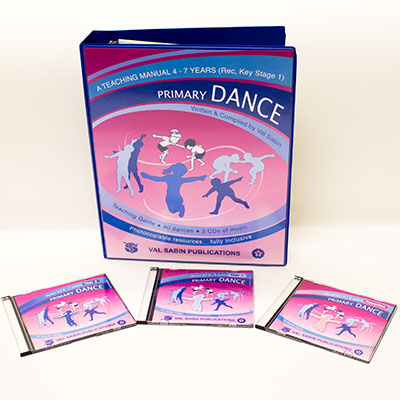Val Sabin Primary School Dance Reception and Key Stage 1 (4-7 Years):

- User-friendly scheme for the whole school.
- A complete scheme of work for Primary School Dance Reception, Year 1 and Year 2 (4-7 Years).
- Teaching guide including planning and assessment sheet.
- 76 lesson plans.
- 40 dances.
- 3 CDs containing 40 tracks of music created for the dances.
- 1 complete unit on English Country Dance.
- Photocopiable resources (in the purchaser’s school only).
- Linked to literacy and other areas of the curriculum.
- Exceeds National Curriculum Requirements.
Dance Reception & Key Stage 1 Sample Pages
View Dance Rec/KS1 Sample Pages
Dance Training
Introduction to Dance Reception and Key Stage 1 (4-7 Years)
The 12 units of work (each with 6 or 7 lesson plans) contain 76 lesson plans that progress and develop 40 dances through 49 pieces of music. The manual exceeds National Curriculum 2014 expectations and can be used as a photocopyable master manual (in your own school only)
The Teaching Guide
The teaching guide gives practical and definite guidance on planning, teaching styles and strategies, choosing and using stimuli for dance, and suggestions for additional forms of accompaniment. It describes the movement material or language of dance, examines the essential aspects of composing, performing and appreciating, and describes how dances are made. Dance activities appropriate for each age group are linked to National Curriculum 2014 requirements. Minimum Expected Standards are identified and assessment sheets provided.
The Teaching Material
Teaching material has been organised to form a complete and detailed scheme comprising 4 units of work (24 or more lesson plans) for each year group, however, flexibility is also built in to allow, for example, the use of dances for reception to be used for Year 1 with more detail of movement or working with a partner. The whole scheme has been written to develop children’s knowledge, skills and understanding, in a progressive manner. Learning Objectives, Expected Learning Outcomes and dance frameworks clarify planning and focus learning.
The lesson plans are written in great detail so they can be used immediately as they stand or adapted to suit the expertise or teaching style of the teacher or the attitude and ability of the class also each dance has an additional page of linked ideas and activities in the classroom.
There is a range of styles of music, 12 traditional pieces of music and 37 pieces of music specially designed for the creative dances.
Lesson Plans
All lesson plans have been tried and tested, however, the rate at which individual classes progress may be very different. Whatever the rate of progress there will always be more than enough material in each lesson plan for one lesson and indeed, in some cases, could be extended to 2 or even 3 lessons.
This abundance of lesson material allows a teacher to choose to deliver, say 4 from 6 dance lessons from a unit for a topic being worked on at the time, then revisit the unit later for the unused lesson material. Throughout the manual there are an additional 32 pages of ideas for dance stimuli and related activities. Many of these activities have photocopiable masters in the appendices.
There is a wide range of musical accompaniment for dances including: simple, complex, orchestral, funky and music for story telling.
Dance Stimuli and links with the wider curriculum
The dances arise from a wide range of stimuli; tactile, weather, story, poem, music etc. The dances gradually progress from individual through to pair and some small group dances generating creative and imaginative ideas. Foundation Stage dances are also provided with suggestions for linked classroom activities.
Throughout the manual, skills and movement materials are obviously repeated, revised and extended in different creative situations.
This enables children to improve the quality and depth of their performances and extend their knowledge and understanding. A gradual development of choreographic awareness and understanding of the language of dance will enable children to observe and appreciate each other’s work and describe what they see and feel, using appropriate vocabulary.
How can you use the scheme?
Long Term Planning
In the Teaching Guide the unit titles are set out in a grid to enable easy identification of Long Term Planning. There is more than enough material available for each year group and this enables schools and teachers to exercise choice when planning. The co-ordinator (in discussion with staff) identifies which of the four units of work will be used in each year group and places them in the relevant time slots.
Medium Term Planning
At the beginning of each unit of work, the medium term plan is detailed. It contains learning objectives, unit framework and expected learning outcomes together with a full page of suggestions for linked classroom activities. For Foundation Stage the Medium Term Plan follows the same format, but in addition outcomes are linked to early learning goals.
Short Term Planning
The detailed lesson plans form the short-term planning. The detailed content allows teachers to use them in a way which is compatible with their levels of confidence and skill.
Price
£90.00 (Hardback)
Please contact us to place your order.

